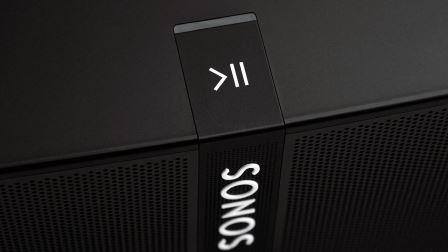Review: The Sonos Play:5 Sounds Amazing, But Is It Worth $500?
Hands on with the best version yet of the innovative wireless speaker system.
I’ve listened to the Beatles’s Abbey Road album thousands of times. From my first five-disc CD player in middle school to my white brick of an iPod years later, the album—along with most of the rest of the Beatles catalog—has been on regular rotation, off and on, for more than half my life. But I’ve never heard it quite like this. Today, I’m listening through a pair of the new Play:5 smart speakers from Sonos.
It’s not that the $500 Play:5 is the highest-fidelity speaker I’ve ever heard (although it does sound excellent). Rather, what makes the song “Sun King” sound different to me this time around is a cross between sound quality and the way the music fills my living room. The mix is more spacious, yes. The guitar tones are a bit more crisp. But I’m not just hearing the song. I’m enveloped in it. And the speakers aren’t even that loud. Yet.
I first got a demo of the new Play:5 back in September at Sonos’s Santa Barbara headquarters, where I went to learn more about how the company’s sound team engineers each speaker to balance the science of acoustics with the nuance of the artists’ intent. It sounded amazing, but then again, I was on the company’s own turf, in a small, theater-like room, probably designed by acoustics nerds for optimal-sounding speaker demos. When I got these sleek-looking, 14-pound boxes into my own living room, I remained impressed.
The new Play:5 is available for pre-sale now and ships at the end of November. Should you rush out and buy one? That depends. It is the best speaker the company has produced to date. Owners of the first generation Play:5 will notice a palpable difference in sound (the new version has twice the acoustic power of its predecessor). If you’re already a Sonos customer and you’ve been thinking about adding a Play:5 to your setup, the new one is worth the extra cash.
If you’re new to Sonos, you might want to start smaller: The $200 Play:1 is still an excellent-sounding speaker, especially given its small footprint. If you know you’re going to want a stereo pair or a multi-room experience right away, a pair of Play:1’s ($400) is a lot more affordable than a pair of Play:5’s ($1,000).
A Page From Apple’s Playbook
The first thing you’ll notice about the new Play:5 is the minimalist, thoughtful design, not just of the speaker (more on that later), but the packaging as well. The box has unusual plastic latches that make it easier to open, and its contents are tucked inside in a way that seems to invite gadget nerds to film unboxing videos and post them on YouTube. Sonos clearly takes a page from Apple’s design playbook here, just as its hardware design makes frequent nods to Jony Ive. Sonos’s team has the lofty of goal trying to redesign the experience of listening to music at home, and its attempt at doing so seems to leave no detail ignored.

Like other Sonos products, the second generation Play:5 is very easy to set up. That’s somewhat remarkable when you consider the complexity of what it does. It’s not a Bluetooth speaker (to the chagrin of some customers), but rather a wireless, high-fidelity home audio system that creates its own mesh network on top of your home Wi-Fi connection, letting you stream music from virtually any source using its proprietary controller app for nearly any modern device. Because it uses Wi-Fi, the strength and location of your home network is important. If your router is two floors above the your Sonos speakers, you may run into issues with laggy playback or paired Sonos units randomly ungrouping themselves. Depending on how your home network is set up, there’s a slight chance you’ll need to move things around or set up a Wi-Fi extender for everything to work properly. But trust me, it’s worth it.
These speakers sound very, very good. They’re not the best-sounding ones you can buy, but they’re light years ahead of any earbud or entry-level desktop speaker. Some higher-end Bluetooth speakers may start to compare acoustically, but nobody else has mastered the multi-room, wireless hi-fi system quite like Sonos has.
Of course, sound quality varies depending on the source. A low-bitrate MP3 or crappy SoundCloud upload isn’t going to magically sound incredible through a Play:5 (although it will likely sound better than you’re used to hearing it). For most of my testing, I used a combination of Spotify tracks and high-bitrate MP3s on my phone, all of which are beamed wirelessly to Sonos via the controller app. You can also hook a Sonos system up to a turntable or standard home stereo system using a pricey accessory called the Sonos Connect ($349). Unlike the smaller, much cheaper Play:1 speaker, the Play:5 has a line-in audio jack, so you can plug it into a home stereo or any other source manually and skip the expensive add-on. I used the line-in to connect Sonos to both my turntable and television.
The second generation Play:5 was totally redesigned from scratch, with no components or design elements recycled from the earlier version. Packed into the device are six drivers, three mid-woofers, and three tweeters for maximum sonic clarity across a wide range of tones. Thanks to its fully enclosed architecture, the new Play:5 is able to achieve bass tones deeper than any other Sonos product, save for its separate subwoofer component. In my testing, I was able to crank the bass in the Sonos app and get rich, deep tones at high volumes without distortion. My cat had never been more terrified.
The Play:5, which comes in white and black, is small enough to fit discreetly into your home entertainment center. But with its rounded corners and sleek, matte finish, it’s neutral-looking enough to sit inconspicuously on a shelf, on your kitchen counter, or even in the bathroom.
Sonos’s designers went to great lengths to build a speaker that doesn’t look like a hunk of consumer electronics. It doesn’t even appear to have buttons. The device includes a new, touch-based interface that sits on the top (or side, depending on the speaker’s orientation) of the Play:5. In a departure from the previous iteration’s tactile buttons, the new UI uses now universally familiar swipe and tap gestures to play, pause, skip tracks and adjust volume. These same controls are accessible from the Sonos app as well, so you already have a remote control for the Play:5 in your pocket.
The interface of the Sonos controller app feels a bit clunky and outdated and requires users to depart from some of the conventions of digital music playback that we’ve grown used to. On the plus side, it lets you plug in almost any digital music source (an Apple Music integration is reportedly in the works) and combine those sources with your own collection. Being able to manage that much music from a single interface is refreshing in this age of fractured, cloud-based music collections.

Indeed, in its customer research, Sonos has discovered that people put their speakers in some very unexpected places (I have a Play:1 underneath my nightstand in my bedroom, and it’s the best alarm clock this non-morning person has ever owned). To compensate for the acoustic consequences, Sonos recently developed a new feature called TruePlay, which uses the microphone on your iOS device (Android is in the works) to read the shape and acoustic properties of a given room and retune the speakers accordingly.
The Play:5 has a few different orientations, each with different-sounding results. An accelerometer inside the speaker knows whether it’s placed horizontally or vertically and adjusts each driver accordingly. In horizontal mode, the Play:5 has a wider stereo image, thanks in part to right and left-firing tweeters that push high frequencies in opposite directions. By far the best sonic results come from pairing two Play:5s together, which spreads out the soundstage even further. At that point, you’re dropping a total of $1,000 on speakers, and while the stereo pair sounds great, it’s probably not $1,000 great for most consumers.

Beyond the sound quality and wireless convenience, the magic of Sonos is twofold: First, there’s the software updates. Over time, the company’s acoustic engineers and developers will push out updates that aim to improve the user experience and tweak the sound of each speaker. So when you unbox a Play:5, it will sound excellent. Two years from now, in theory, it could sound even better.
The other big perk of Sonos is that it’s modular. Buying a new unit doesn’t make your existing Sonos speakers obsolete, but rather lets you extend your home audio setup. The more speakers you add, the better the experience gets. As remarkable as the Play:5s sound, the sound got even more immersive and multidimensional when I grouped them with a Play:1 speaker. Adding more speakers to the mix lets you build out an incredible-sounding home theater system or let the music flow from room to room. This is brilliant from a business perspective, and arguably dangerous for music-loving consumers. The more you use Sonos, the more you wish you had it in every room of your house. And these things aren’t cheap.
The nice thing about Sonos speakers is that they’re designed to stay in your home for several years. So if you start small and get hooked, you can always add other components in the future. If you have the budget, it will probably be a hard impulse to resist.
Fast Company , Read Full Story
(21)













